All uses of the contents herein - and any derivatives thereof - are strictly prohibited without the explicit consent of the author, except for their dissemination without modification thanks to media and social media channels.

Hello!
After some time, I go back to publishing a STEM-themed post, taking a cue from an opportunity that presented itself to me. In the past few weeks, I have started following mycological identification groups on social media channels, becoming more interested in the world of mushrooms.
One day it happens that my parents come back from a route, bringing with them some specimens of mushrooms. At first glance, the mushrooms look like Porcini, but some details not immediately visible make me understand that they may not be the classic Porcinis I usually see around. So, I arm myself with curiosity and start following the steps I had learned earlier to try to identify the mushroom species.
Steps: Which?
The main steps to identify a mushroom are a detailed description of its features.
We start 1) from the general idea, its external appearance at first glance, continuing then with 2) the place and habitat of the finding (for example, the wood type); we continue with the description 3) of the cap, 4) of the portion below the cap and 5) of the stem. For each of these last three parts, it is necessary to observe not only what is visible as it appears, but even its behavior: we have to complete a SLICING of the mushroom and look if there are some changes. An example is the colors TURNING of some mushrooms if they are touched, cut, or pressed in some way.
After pointing it out, I please you to don't consider this post carelessly, because mine isn't the opinion of an expert but only a more structured sketch of a proceeding that a person has to follow if he/she wants to try identifying a mushroom.
Now, go to the description.
I started to repeat these steps on the mushrooms that arrived in my hands. I put them on an absorbent paper foil and I took some shots. I ask my parents where did they find them, and they tell me the mushrooms were “in a prevalent chestnut trees wood” So I began to describe what I was seeing: I will indicate the parts as in the image below, distinguishing the cap, the stem and the hymenophore.
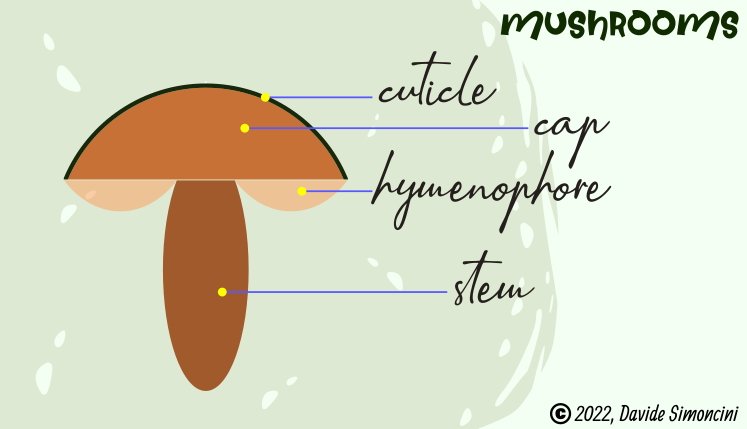
The cap was convex, well colored with brown on all the mushrooms. The smallest ones were 4-5 centimeters about in diameter, and the biggest ones were not more than 15 centimeters. The cuticle is the part you can see as a strong brown, but below you find the flesh: you can see it in the green-circled point of the image below.
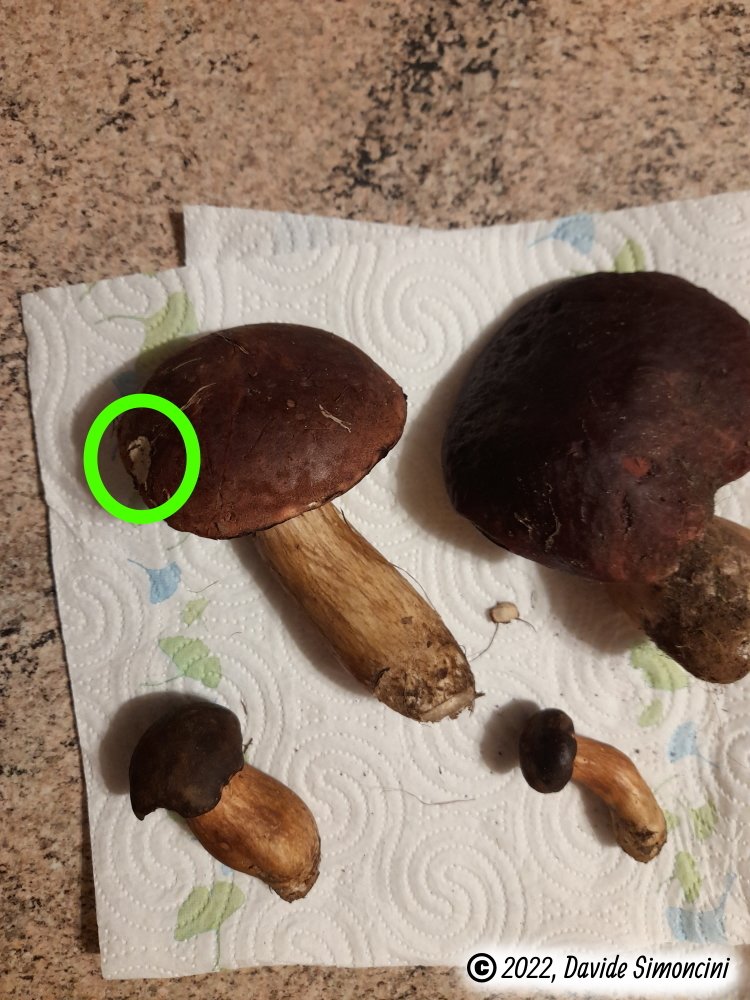
The flesh, in this case, was white. Returning to the cuticle, it seems very "dry”.
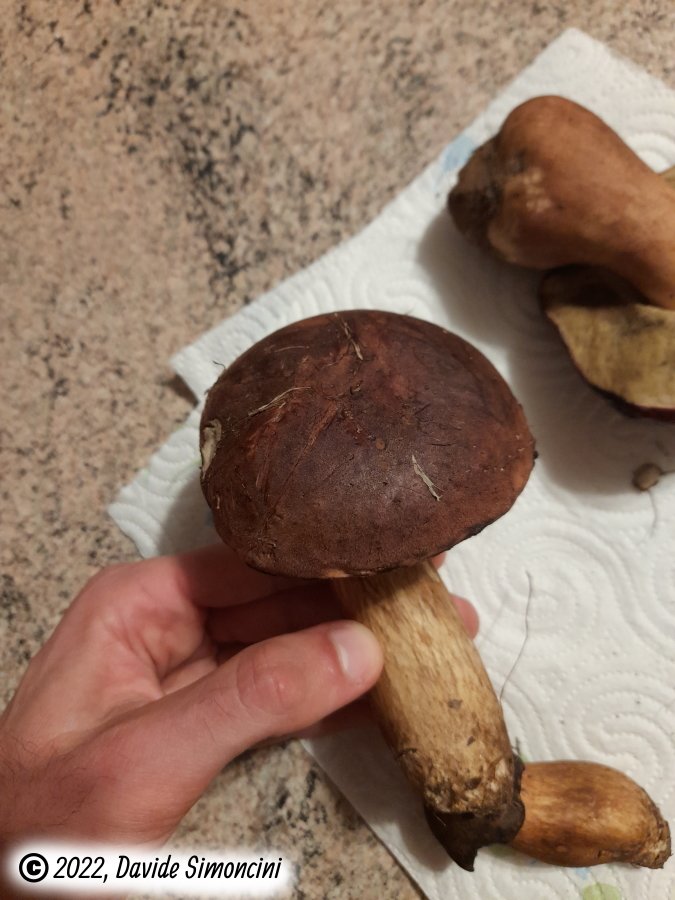
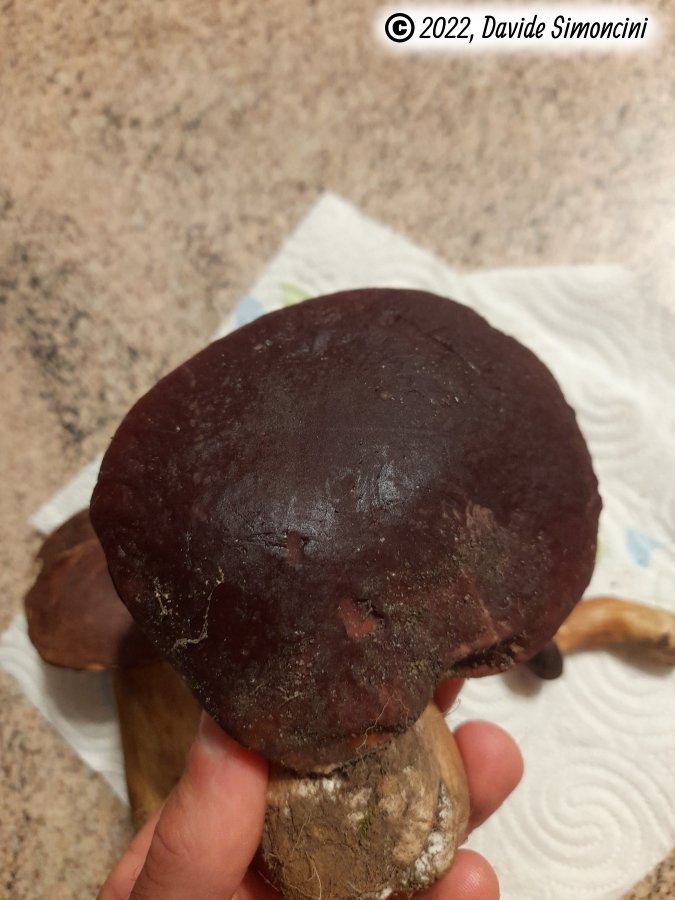
The stem almost never was white, more brown, from light to dark brown, sometimes with an ocher-yellowish tone. It seemed that the colors have been applied in brush-strokes from the low stem to the cap, and without any reticle. In the youngest examples, the color became darker in the middle part of the external surface of the stem, becoming then brighter towards the cap or towards the point where the mushrooms were connected to the ground.
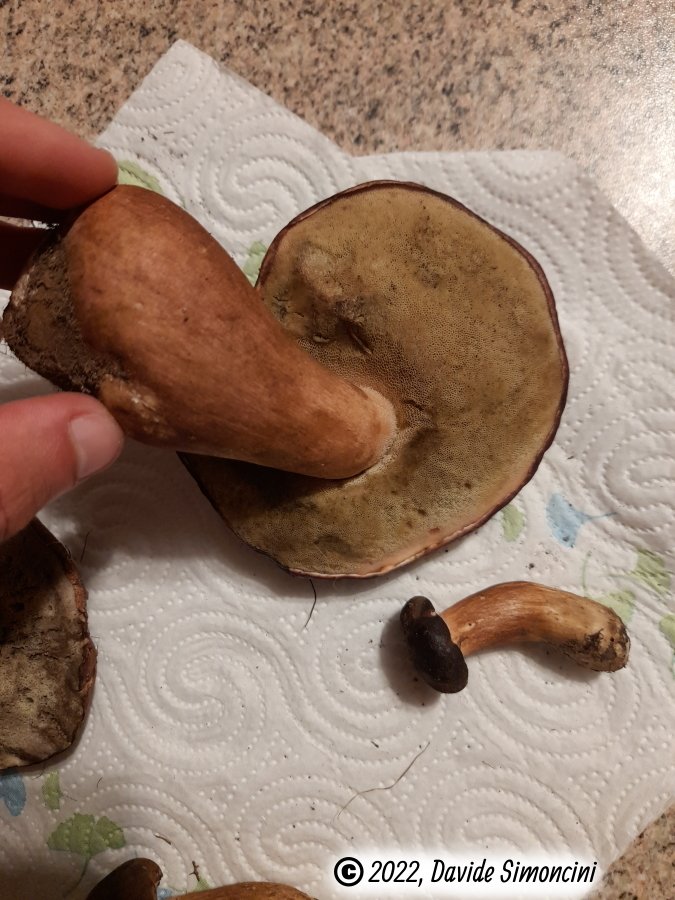
The Hymenophore, in this case, was constituted by pores and – made visible thanks to the next cut - tubes. This part we find below the cap of the mushrooms was the part more different from the classic Porcino mushrooms: the color you can view in the photo ranged between grey/greenish or dust white up to the yellow/greenish of the most mature specimens: colors that anyway were duller than the classic ones I find on a Porcino. But the most important point was that, if touched on the hymenophore, the color turned. This event is indicated as Turning, and, in this case, the color became dark green or dark blue in the pressed zones.
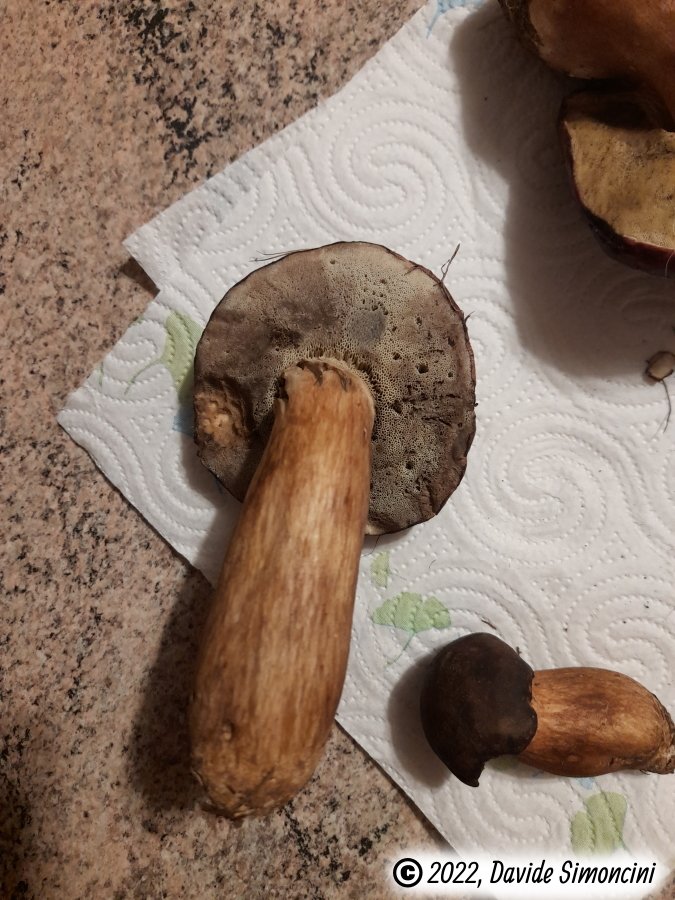
And then the cut or slice, the part we missed: slicing a mushroom means cutting the mushroom in more parts, usually starting with a vertical cut from the cap to the end of the stem. Using this method, we will obtain two halves ready to be described. In my case, I obtained confirmation that the cap flesh was white, that the hymenophore was constituted by tubes, and that the stem flesh seemed fibrous, as well as colored from white to brownish. The most featured observation has been the turning of the cap flesh to a slight blue color, precisely above the hymenophore's tubes. I tried to circle it in the image to make the concept more understandable.
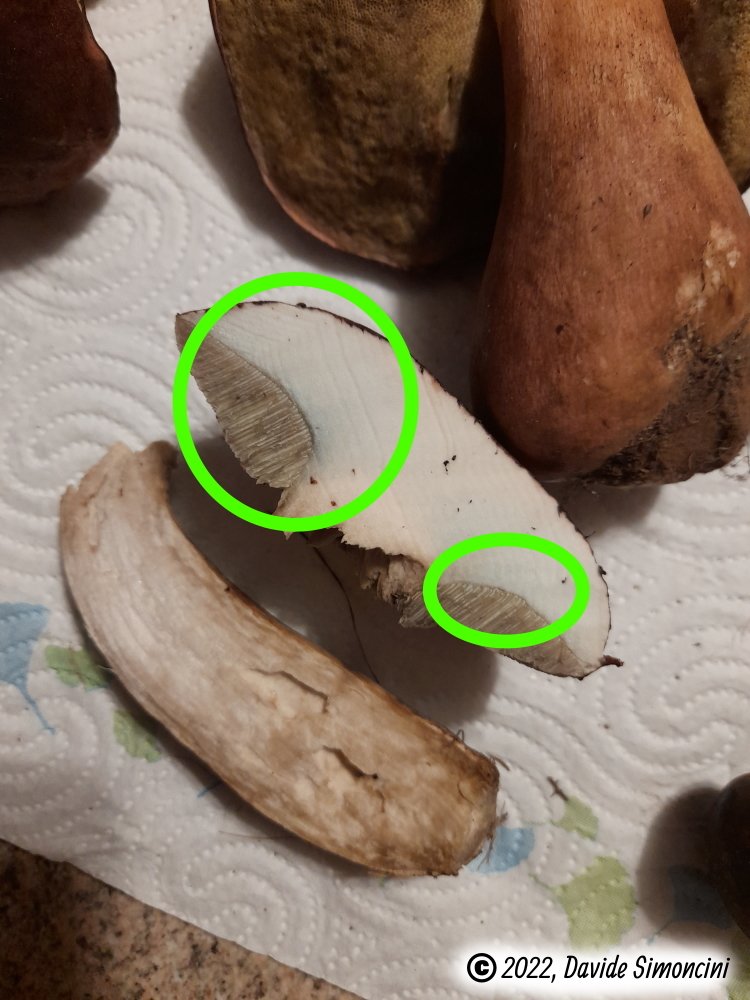
And now, after coming to the end?
At this point, we have to discover the precise type of mushrooms we have in our hands. But here we touch an important side, and I have to be extremely clear: The identification I am describing in this post COULD BE THE WRONG. YOU MUSTN'T USE IT TO DECIDE ON THE EDIBILITY OF A MUSHROOM, but only to find out which is the most likely species with which I have been able to identify it.
I tried to look for news about it thanks to several online sources, and I arrived to express a valid hypothesis: IMLERIA BADIA. Then, I submitted my hypothesis to one of the mycological groups on social media, where some agreed opinions have emerged, never discordant.
Imleria Badia is a taxonomical name dated back to 2014 after molecular studies. Before, it was added between the Boletus Badius and Xerocomus Badius specimens. It is a mushroom type usually considered edible, even if cooking is recommended. A curious news: it seems that this is one of the mushrooms able to accumulate the radioactive Caesium located in the ground (if it is present there).
Apart from this, I repeat that: if you find a mushroom like this, I warmly recommend asking an expert, to know to which specimens it belongs and if it is edible or not. The type of mushrooms often changes for hard-to-individuate small details, especially for people without acceptable knowledge or a keen eye.
I continue repeating that this post has only a didactic goal, not the mushroom identification with the goal of eating it. I make you remember that mushrooms with very dangerous substances exist. The best choice you can do is to always know the species you decide to eat, so you can avoid any consequences.
With this last note, I greet you, leaving the links to various sources where I found many notices about what I talked about before. Tell me if you have questions or curiosities about the focus of the post.
Sources in italian language:
- Photos taken by me
- Imleria Badia, wikipedia.it
- Boletus Badius Castanelli, Funghimagazine.it
- Baio, Universoalpino.com
- Imleria Badia, Funghiitaliani.it
- Funghi e identificazione, social group
- Xerocomus Badius, Salvatore Saitta
- Imleria Badia, Micoponte

Great tips do identify fungi
!1UP
Thank you very much for your curation and gift 🙏😊 !PIZZA
Thanks for your contribution to the STEMsocial community. Feel free to join us on discord to get to know the rest of us!
Please consider delegating to the @stemsocial account (85% of the curation rewards are returned).
Thanks for including @stemsocial as a beneficiary, which gives you stronger support.
The rewards earned on this comment will go directly to the people( @davidesimoncini ) sharing the post on Twitter as long as they are registered with @poshtoken. Sign up at https://hiveposh.com.
You have received a 1UP from @gwajnberg!
@stem-curator, @neoxag-curator, @pal-curator
And they will bring !PIZZA 🍕.
Learn more about our delegation service to earn daily rewards. Join the Cartel on Discord.
I gifted $PIZZA slices here:
@davidesimoncini(1/5) tipped @gwajnberg (x1)
curation-cartel tipped davidesimoncini (x1)
Send $PIZZA tips in Discord via tip.cc!